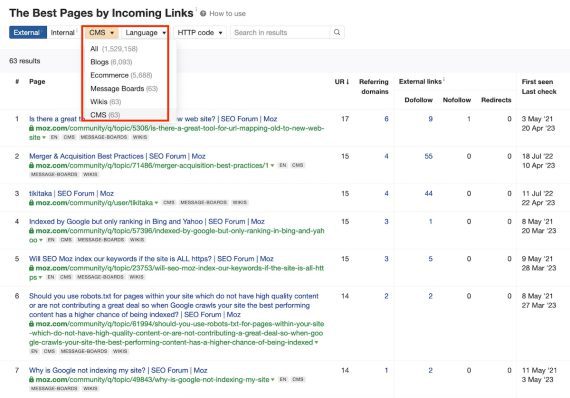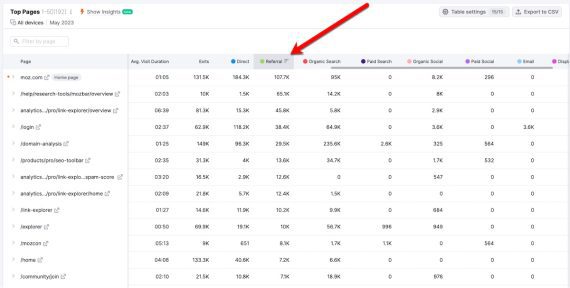Analyzing competitors’ rankings in organic search results can uncover content and backlink opportunities. The first step is identifying the pages to analyze. By traffic? Engagement? Backlinks?
Here are three tools to help.
Semrush: Pages by Traffic
Semrush tracks page traffic for any domain from multiple sources — organic and paid search, social media, email, and display ads. It’s a lot of competitor data to research.
Type a domain, load the data, and proceed to “Traffic Analysis” > “Top Pages.” The report is sorted by “Traffic share,” i.e., the percentage of total domain visits to each page.

Type a domain, load the data, and proceed to “Traffic Analysis” > “Top Pages.” Click image to enlarge.
You can:
- Limit the report to a country
- Filter by device and period, up to two prior years.
- Identify pages with the most traffic in the past month.
- Sort by traffic source.
—
The example below is sorted by “Referral traffic” — pages with traffic from other sites. Those sites are backlink opportunities.
Sorting the report by organic traffic identifies pages for potential ranking opportunities, such as new keywords to target.
The “Insights” section on top of the report shows “Spiked” and “Trending” pages, those with declining and rising traffic.
Buzzsumo: Pages by Engagement
Buzzsumo is helpful for researching competitors’ content marketing tactics. The tool’s “Content Analyzer” report shows all pages from any domain that have generated one or more:
- Facebook reactions, comments, shares,
- Twitter shares,
- Pinterest shares,
- Reddit upvotes and comments.
The report also shows the number of links to a page. In my experience, Buzzsumo’s index is smaller than Semrush’s or Ahrefs’, but it (helpfully) focuses on in-content links, those from articles.
The report is sorted by “Total engagements” and includes an “Evergreen score” for each URL, indicating a page’s engagement growth after the first few days.
Users can filter the Content Analyzer report by date range, useful for analyzing new or dated articles as far as five years back. An email alert feature can trigger when a competitor publishes a new article.

Filter the Content Analyzer report by date range to analyze new or dated articles. Click image to enlarge.
—
Each page includes key metrics such as total engagements, dominant Facebook reactions, top shares, and backlinks.
Ahrefs: Pages by Referring Domains
Ahrefs’ “Top Content” report ranks all pages on a domain or subdomain by the number of referring domains and total shares across Twitter, Facebook, and Pinterest. Sort the report by “Publication date” to find new content.

Ahrefs’ “Top Content” report ranks all pages by the number of referring domains and total shares on Twitter, Facebook, and Pinterest. Click image to enlarge.
Clicking “Details” next to each URL shows its backlinks and anchor text of those links.
The report identifies the most linked content of any site. It is also handy to track the correlation between shares and links. Research a competitor’s content that generated both links and social media shares. Likely those backlinks were organic — i.e., generated virally.
Two separate Ahrefs reports identify a site’s most linked pages.
“Best pages by incoming links” ranks all pages from any domain based on external or internal backlinks — dofollow, nofollow, redirects — with filters by platform type: blogs, ecommerce sites, message boards, wikis, and content management systems.

“Best pages by incoming links” ranks all pages from any domain based on external or internal backlinks. Click image to enlarge.
—
“Best by links’ growth” ranks any domain’s pages by the number of acquired backlinks in a day, week, or month.

“Best by links’ growth” ranks pages by the number of acquired backlinks in a day, week, or month. Click image to enlarge.
Both reports allow searching for a word on a page’s title or URL, helpful for researching a cluster of pages on a topic.
All of Ahrefs’ reports facilitate researching competitors’ link-building strategies.







